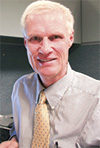I am now reporting to you from Walton, New York. The USDA-NRCS has transferred me to Walton, New York, to work as a planner for the New York City Watershed Agriculture Program. I have been here just over two weeks, so there is much to learn, but here is what I do know.
Just over 20 years ago the city of New York was faced with building infrastructure that would clean its reservoir water to the point of meeting potable drinking water standards. The cost was estimated in the billions of dollars.
The technical advisers suggested that, in place of expensive treatment infrastructure, letâs go upstream in the contributing watershed and help landowners install best management practices that would reduce the flow of contaminants such as manure and sediment into surface water.
Most of the landowners were dairy farmers, but all species of livestock are here. Most of the farms are relatively small given the limited land base for growing crops, with the exception of permanent grass for pasture grazing. Most of the best management practices (BMPs) included containing manure on an exercise area and installing a waste storage facility.
A Watershed Agricultural Council was formed and is now in two locations. The council sought to put together a team of planners and technicians to inventory, evaluate, plan and then oversee the installation of these BMPs.
There are three organizations directly working on this program: the Soil and Water Conservation District (SWCD), the Watershed Agricultural Council (WAC) and NRCS. There are five of us with NRCS: two civil engineers and three resource conservationists who are planners.
As planners, we are developing the conceptual plans with the landowner. In the practical sense, this means we conduct a thorough inventory of the production area where the livestock are fed and housed and then inventory the fields all in terms of overland runoff.
We evaluate this inventory, and with the landowner goals and objectives squarely front and center, we work through the various options for mitigating what we evaluate as resource concerns.
This is exactly the same procedure we use in CNMP development, and really this procedure is the basis of much of our conservation planning effort in NRCS. What is interesting about the arrangement here is the number of technical people housed with us, including SWCD and WAC employees.
Their primary role is implementation. The planner plans (design phase) and the technician implements (operational phase). Sure, there is a solid link between the planner and the implementer, and at the center is the landowner.
The funding source is a tax levy taken from the residents of New York City. We five NRCS employees are paid for out of this levy as well, in the form of a reimbursable agreement.
There are a lot of moving parts, and I will learn more about them in the near future, but on the whole the entire program does make sense: if we can help keep the headwaters of the watershed clean, the city of New York will have reservoirs of water nearer drinking water standards ⌠all at a fraction of the cost that would result if treatment were necessary.
Interestingly enough, the BMPs are paid for by the WAC. In other words, the residents of New York City are paying for a roofed, contained exercise area for a small herd of beef or a waste storage facility for a dairy herd so manure is not applied on sloped snow-covered pastureland during winter and early spring.
The fact that the program is 20 years old and still going strong is telling. New York City is pleased with the results and continues funding the WAC.
At this early stage, I am out meeting with the landowners that have been assigned to me. I understand there are several hundred landowners in the program. Most of them are divided among the three of us that are NRCS planners, and the rest are managed by WAC staff.
For instance, there are dozens of small farms here with a handful or two of animals that are participants; they receive planning and operational assistance as well.
Walton is at the base of the Catskill Mountains, and certainly the terrain here is quite different from the nearly level topography of central Michigan. There are creeks and springs and ditches everywhere that are all reaches contributing to the watershed drainage area.
On every farm visit, I find real challenges in terms of how to manage all this surface water. One dedicated USDA program that helps the landowner is the Conservation Reserve Enhancement Program, or CREP, administered through the Farm Service Agency.
I donât know very much about this program except that its purpose is identifying particularly sensitive areas, those along water courses, and fencing them so grazing animals cannot have access.
This is not a new concept of fencing animals out of creeks and ditches, but here in the New York City watershed, this effort is clearly on top of the planning options. So I will have to learn more about this program very soon.
Another observation is the very limited tillable land base. About the only row-crop work here is along the rivers in the floodplain regions of the alluvial deposits. These rivers do flood, and quite often, so farming these adjacent-to-the-river fields has to be managed carefully.
CREP has a role to play, especially in the floodplain, and yet the challenge is, of course, that these are productive soils and the landowner would like to farm them.
Other CREP projects include fencing animals out of an area of the field with a spring or seep. Doing so helps keep the water from a pollutant load of manure that does not meet water quality standards.
Nearly all of the CREP ground is planted to perennials: largely woody vegetation that helps stabilize the soils and slow the runoff velocity during rainfall periods. PD

Mike Gangwer
Agricultural Scientist
USDA-NRCS





